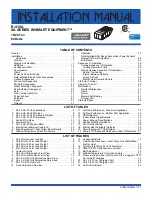
8
facts to consIder aBout the locatIon
Carefully choose a location for the new water heater. The placement
is a very important consideration for the safety of the occupants in
the building and for the most economical use of the appliance.
Whether replacing an old water heater or putting the water heater in
a new location, the following critical points must be observed. The
water heater must be located:
1. On a level surface. Shim the channel type skid base as necessary
if levelling is required.
2. Near a floor drain. The heater should be located in an area where
leakage of the tank or connections will not result in damage to the
area adjacent to the heater or to lower floors of the structure.
When such locations cannot be avoided, a suitable drain pan
should be installed under the heater.
locatInG the new water heater
The pan should be at least 2 inches deep, have a minimum
length
and width of at least 2 inches greater than the dimensions
of the water heater and should be piped to an adequate drain.
The discharge opening of the relief valve should always be piped
to an open drain.
3. Close to the point of major hot water usage and the power
supply.
Hot water piping and branch circuit wiring should be as short as
possible.
Insulate hot and cold water piping where heat loss and condensation
may be a problem.
Heater construction permits installation, maintenance, and service
work to be performed through the front and right side openings.
Suggested clearances from adjacent surfaces are 12 inches on
top, 30 inches in front and 24 inches on right side for access
to the unit.
The heater may be installed on or against combustible surfaces. The
left side and back may be placed flush against adjacent surfaces.
Be sure to place the cover plates over the rear crating couplings
before locating vertical model heaters. The heater may be installed
in a confined space if adequate ventilation is provided.
The temperature of the space in which the water heater is installed
must not go below 32°F or above 122°F.
InstallatIon
reQuIred aBIlIty
INSTALLATION AND SERVICE OF THIS WATER HEATER
REQUIRES ABILITY EQUIVALENT TO THAT OF A QUALIFIED
AGENCY (PAGE 2) IN THE FIELD INVOLVED. PLUMBING AND
ELECTRICAL WORK IS REQUIRED.
General
The installation must conform to these instructions and the local code
authority having jurisdiction. Grounding and electrical wiring connected
to the water heater must also conform to the National Electrical Code,
NFPA 70. This publication is available from The National Fire Protection
Association, 1 Batterymarch Park, Quincy, MA 02269.
Do
not
test electrical system before heater is filled with water, follow
the START UP procedure in the OPERATION section of this manual.
The principal components of the heater are identified in the
Features and Components illustrations on pages 6 and 7.
MIXING VALVE USAGE:
Water heaters are intended to produce hot water. Water heated to
a temperature which will satisfy space heating, clothes washing,
dish washing, cleaning and other sanitizing needs can scald and
permanently injure you upon contact. Some people are more likely
to be permanently injured by hot water than others. These include
the elderly, children, the infirm, or physically/developmentally
disabled. If anyone using hot water in your home fits into one of
these groups or if there is a local code or state law requiring a
maximum water temperature at the hot water tap, then you must
take special precautions. In addition to using the lowest possible
temperature setting that satisfies your hot water needs, a means
such as a
MIXInG ValVe
, should be used at the hot water taps
used by these people or at the water heater.
MIXInG ValVes
for reducing point of use temperature are available.
Consult a qualified installer or service agency. Follow all manufac
-
turer’s Instructions for installation of these valves. Before chang
-
ing the factory setting on the thermostat, read the “Temperature
Regulation” section in this manual, see Page 14.
cheMIcal Vapor corrosIon
This water heater shall not be connected to any heating system(s) or
component(s) used with a non-potable water heating appliance.
Toxic chemicals, such as those used for boiler treatment shall not
be introduced into this system.
Water heater corrosion and component failure can be caused by
the heating and breakdown of air borne chemical vapors. Spray
can propellants, cleaning solvents, refrigerator and air conditioning
Содержание DVE-150, DHE-200
Страница 5: ...5 dimensions and capacities data...
Страница 6: ...6 FEATURES AND COMPONENTS NOTE Your actual configuration may vary DVE Vertical Water Heater typical...
Страница 7: ...7 FEATURES AND COMPONENTS NOTE Your actual configuration may vary DHE Horizontal Water Heater typical...
Страница 11: ...11 electrical and recoveries data TABLE 2...
Страница 19: ...19 NOTES...
Страница 20: ...20 www aosmithwaterheaters com...






































